Dealing with pests in your home can be a nightmare, especially when you’re not sure what you’re up against. Roach poop vs mouse poop look quite different, but both signal unwanted guests in your home. Roach droppings appear as small black specks or coffee grounds, while mouse droppings are dark, rice-shaped pellets about 1/8 to 1/4 inch long with pointed ends.

Click here for pest control management services or here for Rodent Control
These tiny calling cards aren’t just gross—they’re health hazards too. Roach droppings can trigger allergies and asthma attacks, while mouse droppings can spread diseases like hantavirus and salmonella. Level Up Insulation sees these pests regularly in Denver homes, particularly in properties with inadequate insulation.
Proper identification helps determine the right solution. Got black specks near your kitchen cabinets? Probably roaches. Small rice-shaped pellets along baseboards? Mice have likely moved in. Either way, addressing gaps in your home’s insulation creates an effective first line of defense against these unwelcome houseguests.
Clear Signs You Might Have a Pest Problem
Spotting pest infestations early can save homeowners thousands in repair costs and prevent health hazards. Droppings are often the first clue, but several other indicators deserve attention.
Quick Visual Checklist of Common Signs
Physical Evidence:
- Droppings: Mouse poop is pointed at ends (¼ inch), while roach droppings look like coffee grounds or black pepper
- Gnaw marks: Check baseboards, furniture edges, and electrical wires
- Tracks: Dusty surfaces may show tiny footprints or tail marks
- Damaged food containers: Chewed corners on boxes or bags
- Unusual sounds: Scratching in walls, especially at night
Environmental Clues:
- Greasy marks along walls (rodent “rub marks”)
- Musty, ammonia-like odors (mice) or oily, sweet smells (roaches)
- Unexplained food crumbs in strange places
- Small piles of shredded paper or fabric in corners
Many Denver homes face these issues seasonally when pests seek shelter from weather changes.
Why Droppings Are the Most Reliable Early Indicator
Pest droppings provide undeniable evidence of unwelcome guests. Fresh mouse droppings appear black and moist, while older ones turn gray and crumble easily. Roach droppings are smaller and resemble ground coffee.
The location of droppings reveals vital information. Roaches leave droppings along their travel routes, often in kitchen cabinets near food sources. Mice typically deposit droppings near nesting areas and feeding spots.
Quantity matters too. A few scattered droppings might indicate a scout or single pest. Numerous droppings suggest an established colony requiring immediate attention.
Health risks from droppings cannot be overstated. Mouse feces can spread hantavirus, while roach droppings trigger asthma and allergies. Identifying droppings early allows for targeted treatment before these risks escalate.
Invite Users to Submit Photos or Request an Inspection
Not sure what you’re seeing? Take clear, well-lit photos of suspicious droppings or damage for expert identification. Our Denver technicians can usually identify pest types from good images.
For accurate assessment, include a coin or ruler in photos for size reference. Capture multiple angles if possible. Note where you found the evidence and approximate quantities.
Free inspection options:
- 24-hour response time
- No obligation quotes
- Detailed problem assessment
- Customized treatment plans
Don’t wait until a small problem becomes a major infestation. Denver’s climate creates perfect conditions for pests year-round. Our trained technicians bring years of Colorado-specific pest experience to your door.
Call today for peace of mind and protection for your biggest investment—your home.
What Mouse Droppings Look Like
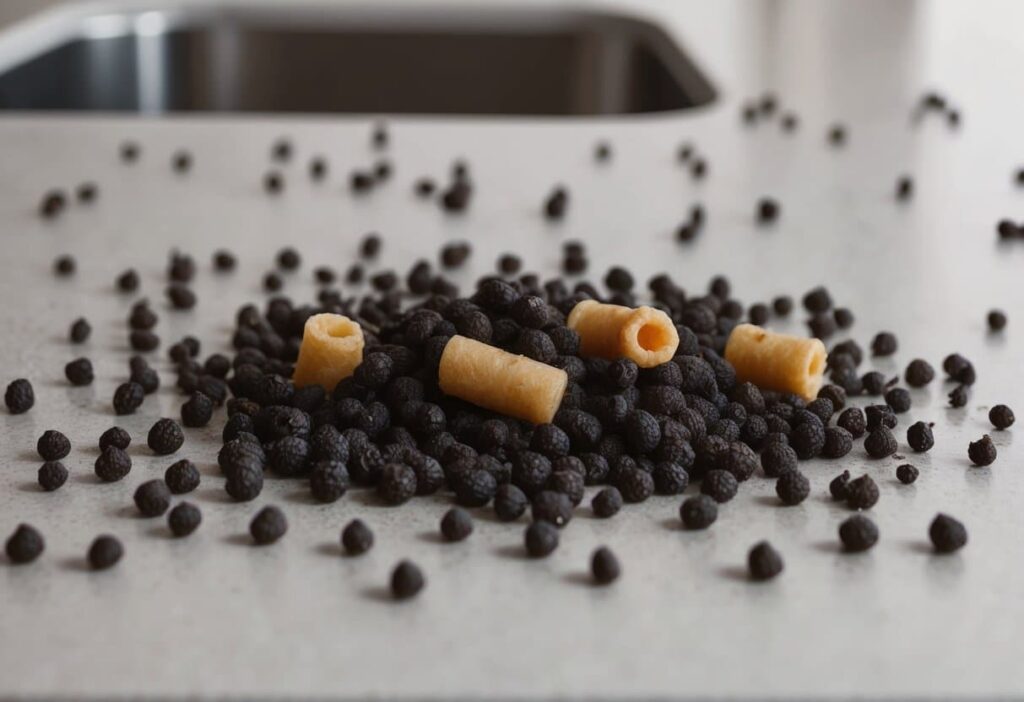
Mouse droppings are telltale signs of a rodent infestation in your home. These small feces can reveal important information about the severity of your mouse problem and how recently they’ve been active in your space.
Shape, Size, Texture, and Color
Mouse droppings are typically rod-shaped with pointed ends, resembling grains of rice. They measure about 1/8 to 1/4 inch in length – much smaller than rat droppings, which can be up to 3/4 inch long.
Fresh mouse poop has a shiny, black appearance and a soft, moist texture. When touched with a gloved hand or tool, fresh droppings might slightly squish.
As they age, mouse droppings become dull, gray, and brittle. The texture changes from soft to hard and crumbly. This transformation happens within 2-3 days, depending on environmental conditions.
Fun fact: A single mouse can produce 50-75 droppings per day! This explains why homeowners often find numerous pellets once mice take up residence.
Fresh vs. Old Mouse Droppings
Fresh mouse droppings indicate active infestations requiring immediate attention. These droppings appear dark and shiny with a moist texture. If you find fresh mice poop, you likely have current unwanted houseguests.
Old mouse droppings look gray, dusty, and crumble easily when touched. They might break apart like dry dirt. This suggests mice were present previously, but doesn’t guarantee they’ve moved on.
Testing droppings can help determine infestation timelines:
- Fresh: Dark, shiny, moist
- 1-2 days old: Still dark but becoming dry
- 3+ days old: Gray, crumbly, dusty appearance
Professional inspectors often evaluate droppings to assess how recently mice have been active in a home and where their traffic patterns occur.
Where They’re Typically Found in the Home
Mouse droppings commonly appear along baseboards and walls where mice travel using their whiskers for navigation. These rodents prefer staying close to edges rather than crossing open spaces.
Kitchen cabinets, especially under sinks and near food storage, frequently harbor mouse feces. The area behind appliances like refrigerators and stoves provides perfect hiding spots with warmth and food access.
Attics, basements, and crawlspaces show heavy dropping concentrations since these areas offer undisturbed nesting opportunities. Denver homes with poor insulation often see more mouse activity in these spaces during colder months.
Garages and storage areas with cardboard boxes create ideal environments for mice to hide and leave droppings. Seasonal decorations rarely accessed become perfect mouse apartments.
Common Scenarios: Food Storage Areas, Nesting Spots
Pantries and food storage areas attract mice seeking easy meals. Check behind cereal boxes and along shelves for scattered mouse poop. Even sealed containers might show evidence of mice trying to chew through the packaging.
Drawers containing linens, especially those rarely used, often become nesting spots. Mouse droppings mixed with shredded material indicate nesting activity rather than just feeding visits.
Utility closets with pipes create perfect mouse highways through homes. Droppings here suggest mice are traveling between rooms using pipe openings and small gaps.
Seasonal storage areas in Denver homes frequently show mouse evidence when opened after long periods. Holiday decorations, camping gear, and winter clothes often contain surprising amounts of rodent droppings when retrieved after months of storage.
What Cockroach Droppings Look Like
Cockroach droppings are distinctive indicators of an infestation that vary in appearance based on species, size, and location. Identifying these droppings correctly can help homeowners take appropriate action before a small problem becomes a major infestation.
How Appearance Varies by Roach Species and Size
Cockroach poop typically resembles small black specks or pellets with ridged edges and blunt ends. German roach droppings measure about 1mm in length with a granular texture. Oriental roaches produce slightly larger droppings with more defined ridges.
Brown-banded roach feces appear as tiny dark specs, often mistaken for coffee grounds. These smaller species leave droppings that might go unnoticed until populations grow substantial.
Different species produce distinctively shaped droppings:
- German roaches: Pepper-like specks
- Oriental roaches: Cylindrical pellets
- Brown-banded roaches: Tiny dark dots
The color ranges from black to dark brown, sometimes appearing reddish depending on the roach’s recent food sources.
Small Species vs. Larger American Roaches
American cockroach droppings are significantly larger than other species, measuring 2-3mm in length. These droppings closely resemble mouse droppings but have ridged sides and blunt ends rather than the pointed tips of mouse feces.
Small German roach droppings might be confused with:
- Pepper flakes
- Coffee grounds
- Dirt particles
Meanwhile, American roach poop is more frequently mistaken for:
- Small mouse droppings
- Rat droppings (when clustered)
- Wood pellets
The quantity matters too. A single American roach produces about 20 droppings daily, while the smaller German roach creates fewer but more numerous pellets due to its colony size.
Smearing or Staining from Heavy Roach Traffic
In severe infestations, cockroach droppings may create dark smears or stains on surfaces. This happens when droppings are disturbed or when roaches walk through their own waste.
These stains often appear along baseboards, in cabinet corners, or behind appliances. Fresh droppings leave smudges when wiped, while older ones harden and require scrubbing.
The stains contain bacteria and allergens that can trigger respiratory issues. Denver homes with central heating provide perfect environments for year-round roach activity, making these stains more common in winter months.
Heavy traffic areas might show grease-like marks from cockroach bodies alongside their droppings. This combination creates distinctive dark streaks along travel paths.
Common Drop Zones: Behind Appliances, Baseboards, Bathrooms
Cockroach droppings concentrate in specific locations throughout homes. The most common areas include:
Kitchen zones:
- Behind refrigerators
- Under stoves
- Inside cabinets
- Along countertop edges
Bathroom areas:
- Around toilet bases
- Under sinks
- Behind shower fixtures
- Along tile grout lines
General household spots:
- Baseboards in dark corners
- Inside electrical outlets
- Under furniture
- Near food storage areas
Roaches prefer dropping in protected, dark locations near food and water sources. Finding these drop zones helps pinpoint nesting areas and traffic patterns. Proper insulation helps prevent roaches from entering homes through wall gaps and ceiling cracks.
Visual Comparison Chart: Roach Poop vs Mouse Poop
Identifying pest waste correctly helps with proper treatment. These small droppings often provide the first clue of an infestation, and knowing the difference can save time and money on pest control.
Shape
Roach droppings have distinct blunt ends and ridges along their surface. They look similar to ground coffee or black pepper grains. Most cockroach species produce droppings with a cylindrical shape, though they may appear slightly irregular.
Mouse droppings, however, have a different appearance. They feature pointed ends that resemble tiny grains of rice. These pellets typically maintain a more uniform shape than roach waste. Fresh mouse droppings appear dark and shiny, while older ones become dry and crumbly.
| Pest | Shape | Resembles |
|---|---|---|
| Roach | Cylindrical with blunt ends and ridges | Ground coffee, black pepper |
| Mouse | Rod-shaped with pointed ends | Rice grains |
Size
Roach droppings measure quite small, usually only 1mm to 2mm long (about the size of a grain of sand or pepper fleck). The size varies slightly depending on the cockroach species – German cockroach droppings tend to be smaller than American cockroach waste.
Mouse droppings are significantly larger, measuring between 3mm to 6mm in length. This size difference provides one of the easiest ways to distinguish between these pests. A simple rule: if the droppings are bigger than a grain of rice, you’re likely dealing with mice rather than roaches.
| Pest | Size | Comparison |
|---|---|---|
| Roach | 1-2mm | Pepper fleck/sand grain |
| Mouse | 3-6mm | Rice grain |
Texture
Roach droppings have a distinctly grainy texture with ridged surfaces. Fresh droppings might appear slightly moist but quickly dry out. They tend to crumble easily when touched, somewhat like dried coffee grounds.
Mouse droppings maintain a more solid consistency. Fresh mouse waste appears shiny and moist but hardens within hours. Old mouse droppings become dry and crumbly, often turning gray with age. Unlike roach waste, mouse droppings won’t disintegrate as easily when disturbed.
Pro tip: Never handle droppings directly! Always use gloves and proper cleaning equipment, as both pests can transmit diseases.
Location
Roach droppings typically cluster in hidden, dark locations. Common spots include cabinet corners, under sinks, behind appliances, and along baseboards. They prefer warm, humid areas close to food sources.
Mouse droppings scatter along their travel paths. These rodents tend to leave “trails” of droppings as they move. Look for them along walls, behind furniture, inside drawers, and near food packages. Mice are less concerned about hiding their waste than roaches.
Both pests target kitchens and food storage areas, but mice range more widely throughout homes. Finding droppings in bedrooms or living areas is more likely to indicate mice than roaches.
Other Clues
Roach infestations often produce a distinctive musty, oily odor. This smell becomes stronger as populations increase. You might also find shed skins (casings) near their droppings. Egg cases called oothecae sometimes appear near waste sites.
Mouse evidence extends beyond droppings. Look for gnaw marks on food packages, furniture, or wiring. Mice leave grease marks along walls and baseboards from their oily fur. Scratching sounds in walls or ceilings, especially at night, strongly suggest mice rather than roaches.
| Pest | Additional Signs | Distinctive Features |
|---|---|---|
| Roach | Musty odor, shed skins, egg cases | Stay hidden, clustered evidence |
| Mouse | Gnaw marks, grease stains, sounds | More visible, scattered evidence |
Health Risks of Each Type of Infestation
Both mouse and cockroach infestations pose serious health threats to your home and family. These pests contaminate surfaces, spread diseases, and can trigger allergic reactions in sensitive individuals.
Diseases and Allergens Spread by Mouse Feces
Mouse droppings carry several dangerous pathogens. Hantavirus Pulmonary Syndrome, a potentially fatal respiratory disease, spreads when people breathe in dust contaminated with infected mouse urine or feces.
Salmonellosis causes fever, stomach pain, and diarrhea when people consume food contaminated by rodent waste. The house mouse is particularly notorious for spreading this bacterium.
Leptospirosis and rickettsialpox are also linked to mouse infestations. These diseases cause symptoms ranging from mild flu-like illness to severe organ damage.
Mouse allergens in droppings trigger asthma attacks and allergic reactions, especially in children. Studies show that 1 in 5 children with asthma are sensitive to mouse allergens.
Roach-Related Asthma Triggers and Food Contamination
Cockroach debris, including feces, shed skin, and dead bodies, contains powerful allergens. These particles become airborne and trigger asthma attacks in sensitive individuals. Children in roach-infested homes have higher rates of hospital visits for asthma.
Roaches crawl through sewage and garbage, then track bacteria onto food surfaces. They spread E. coli, Salmonella, and other foodborne pathogens.
The proteins in cockroach droppings can cause allergic reactions even in people without previous sensitivity. About 60% of urban homes contain detectable cockroach allergens.
Cockroaches also carry parasitic worms and other pathogens that contaminate food and cooking surfaces.
Why Fast Identification and Cleanup Is Critical
Quick action limits exposure to harmful pathogens. The longer droppings remain, the more allergens and bacteria spread throughout your home.
Never sweep or vacuum droppings without proper protection. This action sends particles airborne, increasing inhalation risks. Use gloves, masks, and disinfectants specifically designed for pest waste.
Professional removal ensures complete elimination of contaminated materials. DIY methods often miss hidden droppings behind walls or under appliances.
Prompt action prevents secondary infestations. Other pests may be attracted to the same conditions that brought mice or roaches into your home.
What to Do If You Find Droppings
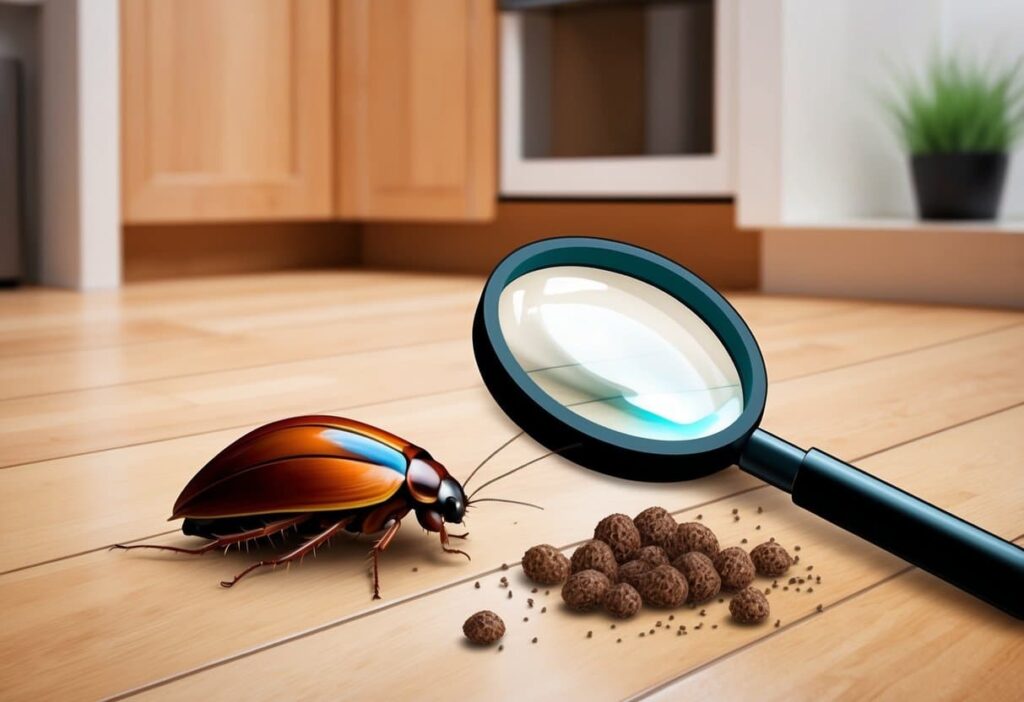
Finding pest droppings requires quick action to protect your home and family. Proper identification and safe removal will help you address the problem effectively.
Safe Cleanup Steps
Never touch droppings with your bare hands. Always wear disposable gloves and a mask to prevent exposure to harmful pathogens.
First, spray the droppings with a disinfectant and let it soak for 5-10 minutes. This kills potential bacteria and viruses before you start cleaning.
Use paper towels to pick up the droppings, then place them in a sealed plastic bag. For larger amounts, a vacuum with a HEPA filter works well, but be sure to dispose of the bag immediately afterward.
Thoroughly clean the area with a disinfectant after removal. Pay special attention to kitchen surfaces, cabinets, and food storage areas.
Don’t forget to wash your hands thoroughly after cleanup, even if you wore gloves!
When to Monitor, When to Call a Professional
For a few isolated droppings, monitoring might be sufficient. Place flour or baby powder near suspected entry points and check for new tracks daily.
Set up a few mouse traps if you spot fewer than 5-10 droppings. Commercial bait stations can be effective for minor infestations.
Call pest control professionals immediately if:
- You find numerous droppings in multiple areas
- You have children or pets who could access traps
- The problem persists after DIY attempts
- You’re unsure which pest you’re dealing with
Professional rodent control services use specialized tools and techniques that DIY methods can’t match. They also identify entry points you might miss.
Red Flags That Point to an Active Infestation
Fresh droppings appear dark and moist, indicating recent pest activity. Old droppings look gray and crumbly.
Hearing scratching sounds in walls or ceilings, especially at night, suggests active rodents. Mice are most active between dusk and dawn.
Finding gnawed food packages, shredded paper, or chewed wires points to nesting behavior. Rodents constantly gnaw to keep their teeth trimmed.
Pets showing unusual interest in certain areas might be sensing pests. Dogs and cats can often detect rodents before humans notice signs.
The distinctive musty odor of mice becomes stronger as the infestation grows. This smell comes from their urine and is particularly noticeable in enclosed spaces.
Book a Same-Day Pest Inspection with Solatera
Denver homeowners trust our expert technicians to identify pest problems quickly. We offer comprehensive inspections that pinpoint entry points and infestation severity.
Our team uses advanced techniques to distinguish between mouse and roach infestations. We’ll create a customized treatment plan based on your specific situation.
All inspections include a detailed report with photos and recommended next steps. No pushy sales tactics—just honest professional advice.
Same-day appointments are often available for urgent situations. Call before noon, and we’ll do our best to have a technician at your door by evening.
Our rodent control services come with a satisfaction guarantee. If pests return after treatment, we’ll come back at no additional cost.
Don’t Rely on Droppings Alone
Identifying pests solely from droppings can lead to incorrect conclusions and ineffective treatment plans. Multiple evidence types provide a more accurate picture of the infestation you’re facing.
Other Signs to Confirm the Source
Mouse infestations leave distinctive signals beyond just droppings. Look for greasy smudge marks along baseboards where their fur rubs against surfaces. Mice also create small, gnawed openings about the size of a dime in food packages or structural materials.
Nocturnal scratching sounds in walls or ceilings often indicate mice scurrying about. They typically build nests using shredded paper, fabric, or insulation in hidden areas.
Roaches, meanwhile, leave behind shed skins, egg casings, and a distinctive musty odor. You might spot them during nighttime kitchen visits when you suddenly turn on the lights.
Remember that both pests prefer similar hiding spots—warm, dark areas near food sources—but their additional evidence differs significantly.
Misidentifications: How Rat, Bat, or Lizard Droppings Can Confuse the Issue
Rat droppings (½-¾ inch) are larger than mouse droppings (¼ inch) and have blunter ends. They’re often mistaken for roach droppings when partially deteriorated.
Bat guano appears similar to mouse droppings but crumbles easily when touched and contains visible insect parts. It’s typically found in clusters beneath roosting spots rather than scattered along pathways.
Lizard droppings feature distinctive white tips (uric acid) and may contain visible insect parts. They’re often deposited on raised surfaces rather than corners.
Even professionals sometimes struggle with identification from droppings alone, especially when:
- The droppings are old or deteriorated
- Multiple pest species are present
- The infestation is in its early stages
Benefits of Expert Pest Identification
Professional pest controllers bring specialized knowledge that goes beyond internet searches. They can distinguish subtle differences between pest evidence that homeowners might miss.
Experts also understand pest behavior patterns specific to Denver’s climate and building styles. This local knowledge proves invaluable for targeting treatments effectively.
Proper identification saves money by preventing the purchase of incorrect treatment products. Denver homeowners often waste hundreds on ineffective DIY solutions before calling professionals.
Most importantly, accurate identification addresses health risks appropriately. Roaches spread different pathogens than mice, requiring distinct sanitation approaches for proper remediation.
With proper identification, our Denver technicians can develop targeted treatment plans that address the specific pest issue rather than using a generic approach.
Why Homeowners Choose Solatera
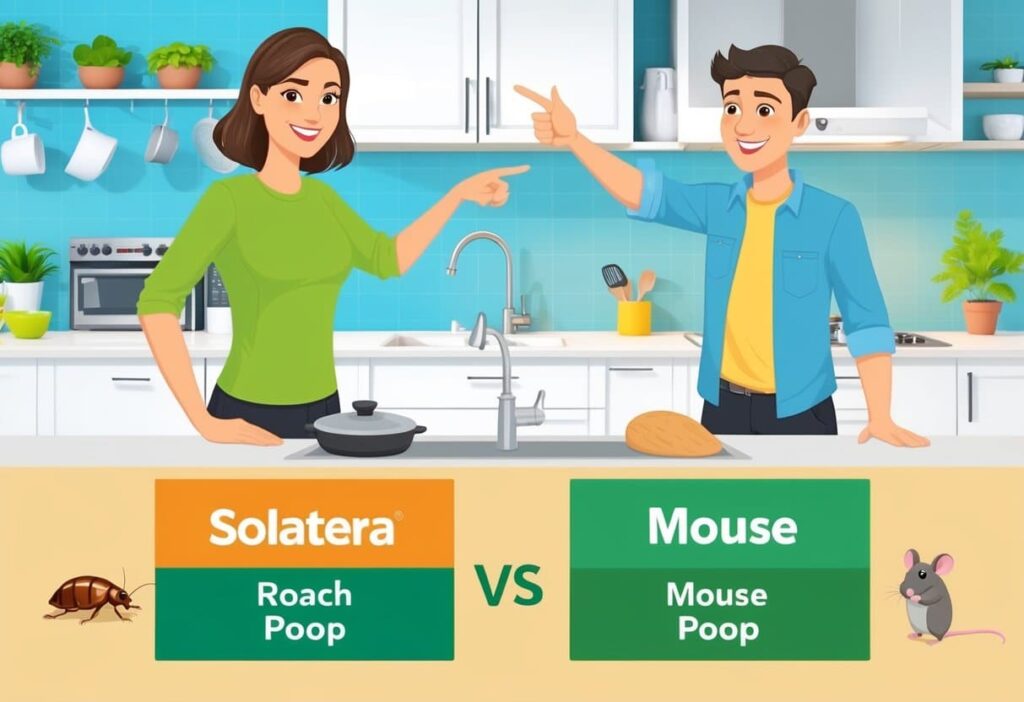
Solatera stands out in pest control by combining effectiveness with safety. Their approach to eliminating both roaches and mice has earned them loyal customers throughout Denver.
Fast, Discreet Service
Solatera responds to pest emergencies within 24 hours, often arriving same day when customers face urgent roach or mouse infestations. Their unmarked vehicles help maintain privacy—no embarrassing pest control trucks parked outside for neighbors to see.
Technicians arrive in professional attire, carrying equipment in discreet bags rather than obvious pest control gear. This thoughtful approach particularly appeals to homeowners in upscale Denver neighborhoods.
The company’s streamlined inspection process takes just 30-45 minutes, with treatment often completed during the same visit. This efficiency means less disruption to busy households dealing with unwanted pests.
Proven Success with Rodent and Roach Control
Solatera boasts a 98% first-treatment success rate for roach elimination, significantly higher than the industry average of 65%. Their multi-faceted approach includes both immediate elimination and preventative measures.
For mice and other rodents, they use a combination of trapping systems and exclusion techniques. Their technicians seal entry points as small as a dime—the size needed for a mouse to enter homes.
Their data shows impressive results:
- 92% fewer callback requests than competitors
- 97% of infestations resolved within two visits
- 100% success rate on comprehensive treatment plans
All technicians complete specialized training in roach behavior patterns and mouse nesting habits, allowing them to target treatments effectively.
Family-Safe, Pet-Safe Treatment Options
Solatera prioritizes safety without compromising effectiveness. They use EPA-approved products with the lowest toxicity ratings possible for indoor use. All treatments are applied with precision to target pests while minimizing human exposure.
Their pet-safe approach includes:
- Placing baits and traps in areas inaccessible to pets
- Using gel-based treatments that dry quickly
- Offering completely chemical-free options for sensitive households
For homes with children, Solatera applies treatments primarily to enclosed spaces and uses barrier methods rather than broadcast spraying. They provide detailed safety instructions after service, including recommended waiting periods before re-entering treated areas.
Many Denver families appreciate that Solatera offers organic treatment alternatives, particularly useful for kitchens and food preparation areas.
Transparent Pricing, No Pushy Upsells
Solatera provides clear, upfront pricing with no hidden fees. Their estimates include a complete breakdown of costs, and technicians don’t work on commission, eliminating the pressure tactics common in the industry.
Their pricing structure includes:
- Free initial consultations
- Flat-rate pricing by infestation type and home size
- No extra charges for weekend appointments
- 60-day guarantee with free follow-up treatments if needed
Customers receive a detailed treatment plan before work begins, with options clearly explained. The company never recommends unnecessary services, focusing instead on what’s actually needed to solve the specific pest problem.
This honest approach has earned Solatera a reputation for integrity in the Denver pest control market.
Highlight Customer Reviews or Link to Case Studies
Solatera maintains a stellar 4.9/5 rating across review platforms with over 800 verified reviews. Customers consistently mention their thoroughness and effectiveness at identifying the difference between roach and mouse infestations.
The Alvarez family in south Denver described their experience: “They eliminated our roach problem in one visit after we’d struggled for months using store-bought products.”
Another success story comes from the Highland neighborhood, where a homeowner wrote: “Solatera found mouse entry points three other companies missed. Problem solved in a week!”
Their case studies document particularly challenging situations, including multi-unit buildings with severe infestations and historic homes requiring special treatment approaches. These detailed examples showcase their problem-solving abilities and commitment to finding permanent solutions rather than temporary fixes.
Schedule Help Before It Gets Worse
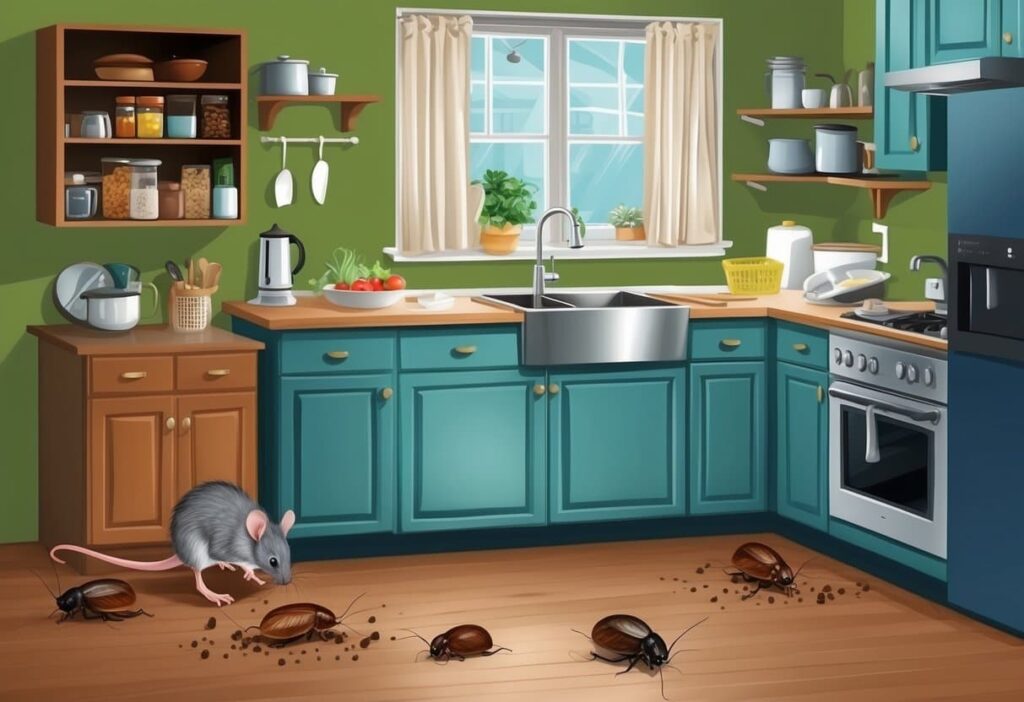
Finding droppings in your home indicates an active pest problem that requires immediate attention. Pest populations grow exponentially when left unchecked, turning a small issue into a major infestation.
Droppings Today Often Mean Nesting Nearby
When you spot roach or mouse droppings, it’s rarely just a passing visitor. These pests typically establish nests within 10-30 feet of where droppings appear. Mice build nests in quiet, undisturbed areas using shredded paper, fabric, and insulation. Cockroaches prefer warm, dark crevices near food and water sources.
The presence of droppings in multiple locations suggests the pests have already claimed your home as their territory. Remember: visible droppings represent only a fraction of the actual population.
Denver homes face unique pest challenges due to seasonal changes, with mice seeking warmth in fall and winter.
Small Infestations Grow Quickly and Quietly
Pest populations explode at alarming rates without intervention:
| Pest Type | Reproduction Rate | Time to Serious Infestation |
|---|---|---|
| Mice | 5-10 babies every 3 weeks | 2-3 months |
| Cockroaches | 30-40 eggs every 30 days | 1-2 months |
A single pregnant mouse or roach entering your home can lead to hundreds of offspring within months. Most homeowners don’t notice until the population has already multiplied several times.
These pests are masters of stealth, staying hidden in walls, under appliances, and inside cabinets. By the time droppings become obvious, you’re dealing with an established colony.
Eliminate Pests at the Source, Not Just the Signs
Cleaning up droppings addresses the symptom, not the cause. Effective pest control requires:
- Professional inspection to identify entry points and nesting areas
- Targeted treatment of specific pest species
- Exclusion methods to prevent future access
- Sanitation improvements to remove attractants
DIY solutions often fall short because they miss hidden access points and nests. Professional exterminators use specialized equipment to reach deep into wall voids, attics, and crawl spaces where pests hide.
Denver’s temperature fluctuations create unique pest pressure points around foundation cracks and roof lines that experts know to check.
Direct Users to a Contact Form, Chat Button, or Phone Number
Don’t wait until droppings appear throughout your home. Level Up Insulation’s pest control experts can identify and eliminate infestations before they spiral out of control.
Our Denver-based technicians provide same-week appointments and emergency services for severe cases. We use child and pet-friendly treatments that target pests, not your family.
Call (303) 555-1234 for a free inspection and quote.
Click the blue chat button in the corner of your screen for immediate assistance.
Schedule online through our easy form at denverinsulation.com/pest-control for $25 off your first treatment.
Frequently Asked Questions
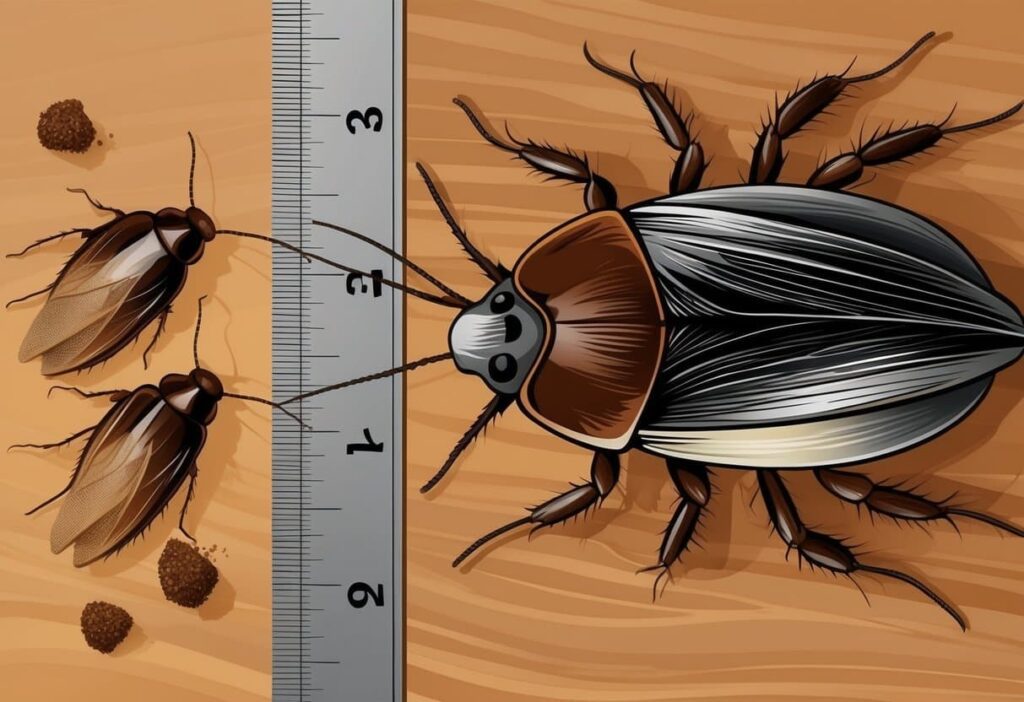
These common questions address key differences between roach and mouse droppings, associated health risks, and proper cleaning methods.
How can you distinguish between cockroach and mouse droppings?
Cockroach droppings look like small black specks or coffee grounds, typically measuring 1mm in diameter. They often appear in clusters in dark corners.
Mouse droppings are larger, about 1/4 inch long with pointed ends. They resemble dark rice grains and tend to scatter along walls or near food sources.
The pattern matters too. Roaches leave random clusters while mice create trails as they move between nesting and feeding areas.
What are the potential health risks associated with cockroach droppings?
Cockroach feces contain allergens that trigger asthma attacks and allergic reactions, especially in children. These allergens remain potent for months.
Roach droppings may carry harmful bacteria, including Salmonella and E. coli. These pathogens can contaminate food preparation areas and cause illness.
Some studies link prolonged exposure to cockroach allergens with the development of chronic respiratory conditions.
What does cockroach feces look like on walls?
On walls, cockroach droppings appear as tiny black or brown smear marks or specs. They often cluster in corners and along edges where walls meet.
In severe infestations, these marks might form visible dark streaks running vertically on walls, especially near cracks or hiding spots.
The droppings may stain light-colored surfaces and prove difficult to remove without proper cleaning products.
Are there differences between droppings of various cockroach species?
German cockroach droppings are tiny and pepper-like. They’re often found in kitchens and bathrooms.
American cockroach feces are larger and more cylindrical, resembling small pellets rather than specks.
Oriental cockroaches produce blunter, less defined droppings that may appear more moist than other species’ waste.
What consistency should you expect from cockroach droppings?
Fresh cockroach droppings have a slightly moist, paste-like consistency. They darken and harden as they dry out.
The texture varies based on the roach’s diet. Droppings from roaches eating greasy foods appear shinier than those consuming dry goods.
When touched (though we don’t recommend it!), dried roach droppings crumble easily into a fine powder.
What are the best methods for cleaning cockroach feces?
Always wear gloves and a mask when cleaning roach droppings to avoid inhaling allergens. HEPA vacuum cleaners work best for initial removal.
Disinfect affected surfaces with a mixture of bleach and water (1:10 ratio) or commercial disinfectants specifically designed for pest waste.
For stubborn stains on walls, try hydrogen peroxide or specialized enzymatic cleaners that break down the organic components of the droppings.
